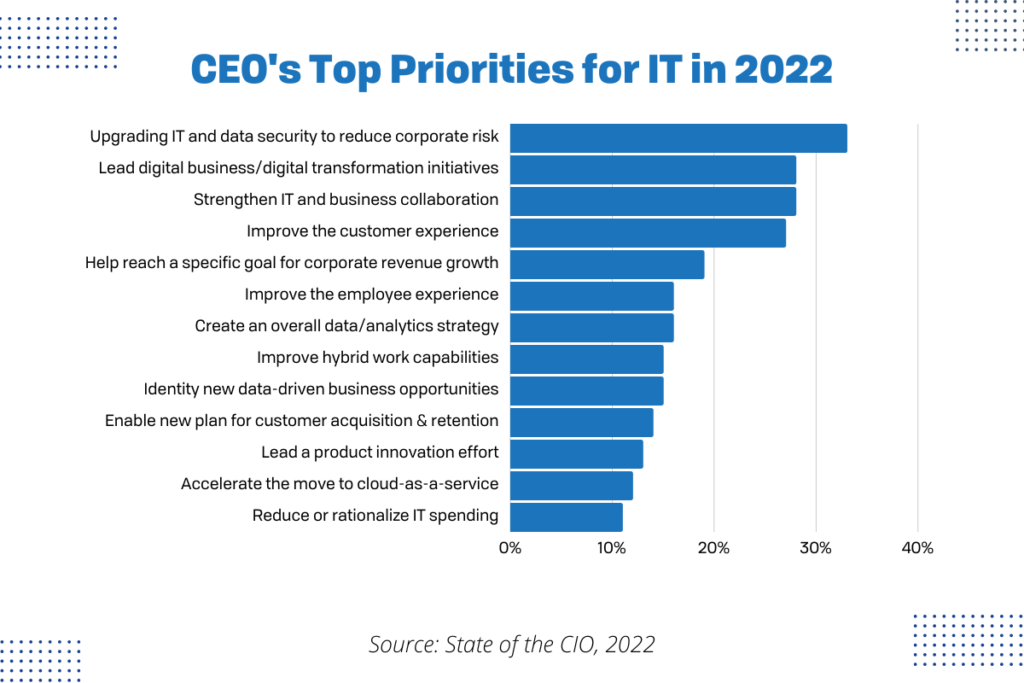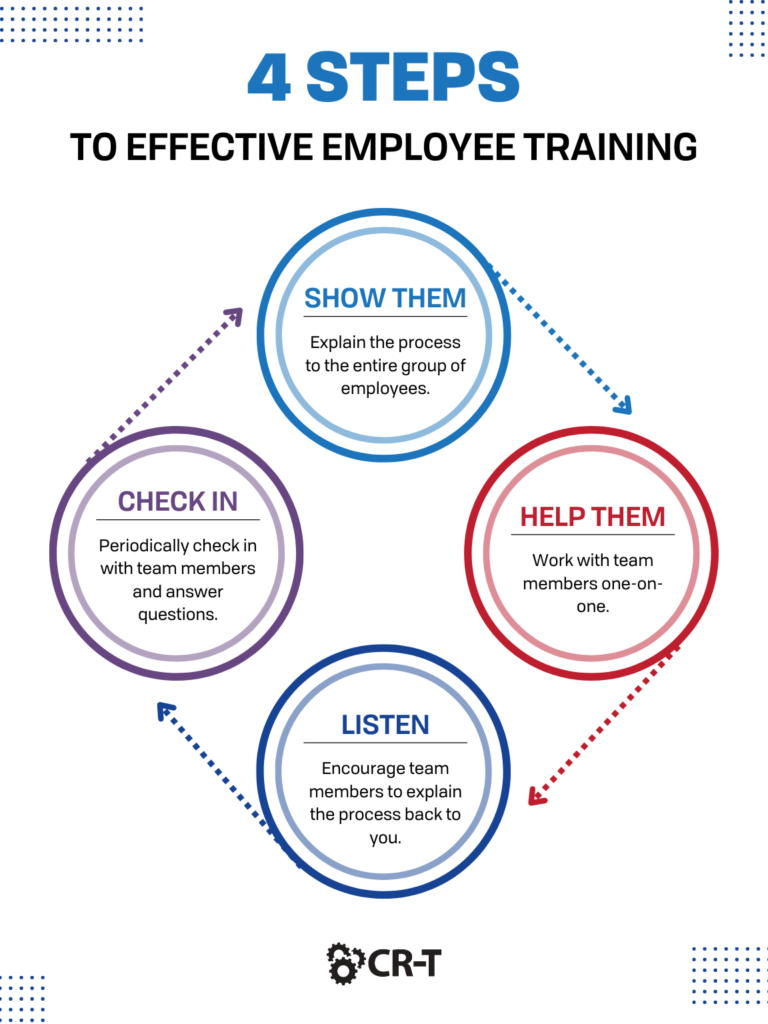It’s no surprise that technology has completely revolutionized the business world.
You’re already seeing the benefits of emerging trends, and many of you have been implementing new technology successfully for years.
To help you streamline the process, here are 5 steps for integrating new technology into your organization:
- Identify Your Organization’s Needs.
- Investigate Technologies That Will Solve Problems for Your Organization.
- Develop a Plan for Implementing Your New Technology.
- Train Other Employees in Using the New Technology.
- Launch, Fine-Tuning the Technology to Fit Your Needs as You Go.
Step 1. Identify Your Organization’s Needs.
Before you begin investing hundreds or thousands of dollars in new technologies, make sure you have a clear understanding of why you’re adopting this new technology and how it will benefit your business.
Is your organization adopting this technology to:
- Reduce costs?
- Increase productivity?
- Facilitate collaboration between team members?
- Replace outdated technology?
- Track overall progress?
It’s also a good idea to include other employees in workplace decisions. While the question of whether to purchase new software may be non-negotiable, you can still allow employees to offer opinions on which specific solution you’re buying.
Discuss your team’s pain points and encourage honest feedback and suggestions from employees, leaders, and managers in each department.
Giving employees a say in the outcome will transform your technology adaptation from an inconvenience to a collaborative effort that makes the organization more successful.

Step 2. Investigate Technologies That Will Solve Problems for Your Organization.
Now that you’ve established your organization’s priorities and pain points, it’s time to begin researching technologies that will help you solve your company’s problems.
The correct solution will depend on a variety of factors, but here are a few ideas to get you started.
1. Cybersecurity
Although cybersecurity isn’t a new concept, it’s still just as important as it was when it was first introduced. And the field of cybersecurity has evolved dramatically from what it was a decade ago.
Behavioral analytics allows organizations to detect suspicious behavior quickly in order to neutralize potential threats.
Threat Detection and Response (TDR) solutions offer full visibility into all attack vectors and generate high-quality alerts with low false positive rates.
And a zero-trust model of cybersecurity assumes that any component inside or outside a network can pose a potential threat, placing a greater emphasis on access control and endpoint security.
When it comes to cybersecurity, there are endless opportunities to introduce new technology into your organization.
2. Artificial Intelligence (AI) and Machine Learning
Like cybersecurity, Artificial Intelligence (AI) has made significant strides over the last decade, and it remains one of the leaders in technological advancements.
According to DataProt, the global AI market value is expected to reach $267 billion by 2027.
Intelligent Automation (IA) is already being utilized across a variety of industries for onboarding, employee training, customer service, and more.
Artificial Intelligence for IT Operations (AIOps) can manage data, detect anomalies, and automate pattern discovery and prediction. AIOps simplifies IT Ops management and accelerates problem solving in complex IT infrastructures.
In the world of cybersecurity, AI can detect vulnerabilities across various endpoints, workloads, and systems.
When you’re brainstorming ways to improve efficiency and reduce costs, look no further than AI.
3. Cloud Computing
What was once a new technology trend, cloud computing has now become mainstream, with major players like Amazon Web Services (AWS), Microsoft Azure, and Google Cloud dominating the market.
However, there are several branches of cloud technology that are expected to grow substantially over the next few years.
Serverless computing, or Function as a Service (FaaS), provides an easily scalable cloud environment for developers to write and deploy code. FaaS also offers a pay-as-you-go model, automatically scale up and down based on demand.
The hybrid cloud combines the strengths of public and private clouds to offer organizations greater flexibility and more deployment options. Similarly, a multi-cloud infrastructure allows you to utilize services from multiple cloud providers.
Secure Access Service Edge (SASE) combines Wide Area Networking (WAN) with network security services into a single, cloud-delivered service model. This gives you greater flexibility and security, along with increased performance and cost savings.
Finally, edge computing provides you with an alternative to cloud computing by processing client data at the periphery of the network, as close to the originating source as possible. This proximity to data comes with multiple benefits, including faster response times and better bandwidth availability.
Cloud computing isn’t going away anytime soon, and these technologies will transform your cloud environment from elementary to highly sophisticated.

4. Internet of Things (IoT)
Another promising technology trend that has been around for years but is continuing to develop is the Internet of Things (IoT).
As consumers, we’re already using and benefiting from IoT technology. Smart homes allow you to lock your door and preheat your oven remotely while out for a walk, all while tracking your steps on a Fitbit.
But the IoT is influencing businesses as well, and today’s technology is only the beginning. Statistica predicts that by 2030, around 50 billion IoT devices will be in use around the world.
5. Blockchain
Although most people think of blockchain technology in relation to cryptocurrencies such as Bitcoin, blockchain offers security that’s useful in many other ways as well.
Put simply, a blockchain is a series of storage containers, or “blocks,” of data. Blocks have certain storage capacities and, when filled, are closed and linked to the previously filled block, forming a chain of data.
Since blocks can’t be altered once they’re added to the chain, they’re virtually impossible to hack or overwrite.
Although blockchain is primarily used in the finance industry, its impenetrable security features make it an attractive technology to utilize across other industries as well.
6. Fifth Generation Wireless 5G
No list of emerging technology trends would be complete without mentioning the latest innovations in mobile devices.
Right now, all eyes are on 5G.
Where 3G and 4G technologies have enabled us to browse the internet, use data driven services, and more, 5G will provide more connectivity than ever before.
Higher speeds, improved reliability, and reduced latency are only a taste of what 5G has to offer. 5G will also enable a sharp increase in the amount of data transmitted over wireless systems due to more available bandwidth and advanced antenna technology.
5G networks and services will be deployed in stages over the next several years to accommodate the increasing reliance on mobile devices. Overall, 5G is expected to generate a variety of new applications and technologies that will benefit individuals and businesses.

Step 3. Develop a Plan for Implementing Your New Technology.
Once you’ve decided on a new technology to adopt, you’ll need to create a plan for implementing this technology.
Assign a person or team who will create a project timeline, gather necessary resources, oversee administrative details, and manage conflicting priorities.
Partnering with an IT project services team will provide you with additional expertise and resources when it comes to integrating your chosen technology. An outside team will offer you a fresh perspective and will free up your time and resources to focus on other opportunities.
Communicate with your IT project services team regularly to make sure you’re on the same page. A project management calendar is an excellent tool to ensure that your processes stay organized, and establishing progress points with a visual representation will keep everyone on track.
As you approach the end of development, it might be a good idea to create a pilot program. That way, you can more easily demonstrate the new technology to other departments in the organization, as well as work out any kinks.
Step 4. Train Other Employees in Using the New Technology.
Once you’re ready to implement the new technology, one of your largest roadblocks will be ensuring that other employees understand how to use the new technology.
Not all technologies are user-friendly, and it will probably take several weeks or months before everyone in the organization has fully adopted and grown accustomed to the new technology.
Provide engaging training sessions and focus on the value this new technology will add to each employee’s day-to-day work. It’s also a good idea to ask for feedback from users at every stage of the implementation.
Many SaaS and other technology providers assign an expert to aid you in the process of implementing your new technology. Take advantage of their expertise and seek advice on the best ways to train your team.
Your technology provider might also offer free training programs that walk users through every function and feature of the program. Identify which sections would be most useful to each employee and encourage them to complete the relevant training.

5. Launch, Fine-Tuning the Technology to Fit Your Needs as You Go.
With all technology, ongoing support is essential.
So the final step for the successful integration of new technology is to continue to evaluate its performance post-installation.
Ideally, support should be a fundamental part of your strategy to implement the new technology. By the time something has gone wrong, it’s already too late to create an entire support plan. So anticipate issues ahead of time and continue to resolve problems as they arise.
This is another area where an IT project services team is especially helpful. By integrating your project services with Managed IT Services, you can enjoy continued support and the ability to adjust as needed.
FAQs About Implementing New Technology
Q: How do I know which technologies to implement in my organization?
A: Begin by identifying your organization’s priorities and pain points. Then research technologies that offer a solution to your company’s problems.
Q: Once I’ve chosen a new technology, how do I go about integrating it?
A: Develop a plan for implementing your new technology. Partner with an IT project services team to offer support and guidance throughout the transition.
Q: How do I train other employees in using the technology?
A: Focus on the value the new technology will add to each employee’s day-to-day work. Take advantage of any resources provided to you by your technology provider, such as training videos or a team member to guide you through the transition.
Conclusion
Implementing new technology can feel overwhelming, but we know that you’re up to the challenge.
When you follow the steps above, you’ll see just how quickly you can reap the benefits that new technology has to offer.
Start today by checking out the latest and greatest in IT products.
And before you know it, your organization will be thriving and working more effectively than ever before.
Blog & Media
Cloud Services
Managed IT Support
Cyber Security
Project Services
Servers/Infrastructure
Firewalls
Networking
Hardware/Software
Microsoft Products/Cloud
Amazon Web Services
Penetration Testing vs Vulnerability Scanning
If you’re responsible for managing the security of your organization’s network or systems, you may have heard the terms “penetration testing” and “vulnerability testing” thrown
Backup and Disaster Recovery
Your organization can’t afford to neglect backup and disaster recovery. If it takes your business too long to get back online after a disaster, you
6 Steps to Secure Customer Data
Securing customer data is essential for one major reason: your business depends on it. As an IT director, you recognize the importance of cybersecurity when
5 Steps to Promote Compliance in the Workplace
You’re familiar with the ever-changing world of regulatory compliance. Robust compliance enables you to avoid legal liabilities while improving your organization’s effectiveness. And many of

